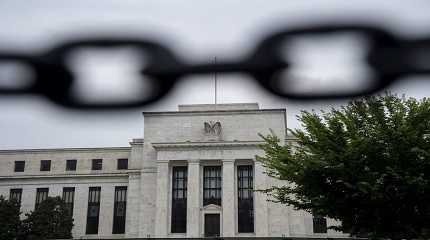
NEW YORK, Dec. 16 (Xinhua) -- Wall Street had a painful day on Thursday as hawkish messages from the Federal Reserve stoked recession fears, and analysts warned of more market struggles ahead as macro environment remains unfavorable.
The Dow Jones Industrial Average shed 764.13 points, or 2.25 percent, to end at 33,202.22, its worst day since September. The S&P 500 dipped 99.57 points, or 2.49 percent, to 3,895.75. The Nasdaq Composite Index tumbled 360.36 points, or 3.23 percent, to 10,810.53.
The sell-off was steep and broad, which saw all the 11 primary S&P 500 sectors finish in red, with the communication services and technology down 3.84 percent and 3.78 percent, respectively, leading the slide.
Markets focused on "the possibility of a recession," as the Fed on Wednesday raised interest rates for the seventh time this year, bringing the federal funds rate to a range of 4.25 percent to 4.5 percent, the highest level in 15 years, LPL Financial's Chief Global Strategist Quincy Krosby told Xinhua via email Thursday.
The Fed also signaled that it will continue to raise rates in early 2023, and will not begin to cut them until 2024, in an effort to rein in the fastest-growing inflation in decades.
At a press conference following the announcement, Fed Chair Jerome Powell said the central bank still had "some ways to go," and the central bank would require "substantially more evidence" before concluding that inflation was falling sustainably.
Meanwhile, the Fed predicted slower growth and higher unemployment, deeming the labor market "extremely tight," with "wage growth elevated" at a level inconsistent with hitting the Fed's 2 percent inflation target, which fueled fears about a looming U.S. recession.
"The equity market's reaction is now factoring in a recession, and rejecting the possibility of the soft landing mentioned recently by Powell at the Brookings Institute," Krosby said.
The yield on the benchmark 10-year U.S. Treasury note fell by 5 basis points to 3.45 percent on Thursday, while the 2-year Treasury yield declined about 2 basis points at 4.23 percent.
A scenario in which short-term yields exceed long-term yields is known on Wall Street as an inverted yield curve and is often seen as a harbinger of slower economic growth, or even a recession.
"The 10-year Treasury yield has fallen below 3.5 percent, suggesting a growth scare. The yield curve inversions continue to shout recession," said Krosby.
U.S. economic data released Thursday added to investor anxiety. A fall in first-time claims for unemployment benefits in the week ending Dec. 10 underlined the Fed's concern that demand for labor remains in excess of supply.
U.S. retail sales in November fell 0.6 percent month-over-month, the largest decline in 11 months, highlighting consumer budgets are under pressure.
Moreover, market volatility is expected to persist in the foreseeable future as the fundamental challenges of higher rates and slowing growth will linger, experts warned.
"The cumulative effect of rate hikes has yet to be felt widely throughout the economic landscape, while the ramping up of Quantitative Tightening (QT) will also introduce a tightening reaction to markets and the economy at large," said Krosby.
Despite Thursday's slump, the S&P 500 is now around up 8.9 percent from its 2022 low struck in mid-October.
"We do not see this as fully reflecting the drag on growth imposed by prior tightening," analysts at UBS said in a note on Thursday, adding "risks remain for a further retracement" and market swings are likely to prolong.
Larry Benedict, CEO & founder of The Opportunistic Trader, a U.S. market research firm, told Xinhua that he expects a continued bumpy road ahead for markets, noting the first quarter of 2023 will be "rough."
"We do not think the macroeconomic preconditions for a sustained market rally are yet in place. We view the risk-reward outlook for the next three to six months as unfavorable," UBS analysts said.




